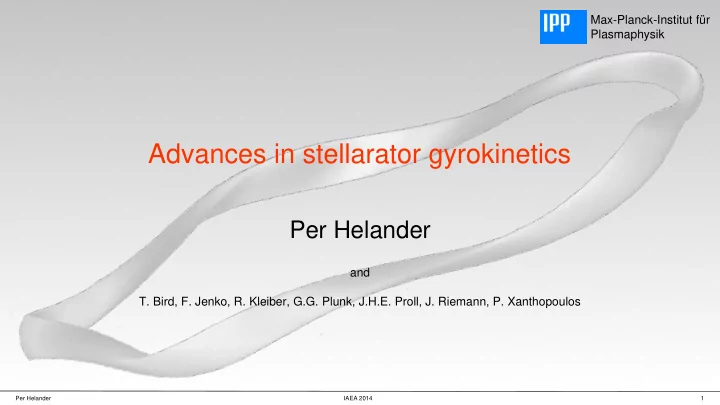

Max-Planck-Institut für Plasmaphysik Advances in stellarator gyrokinetics Per Helander and T. Bird, F. Jenko, R. Kleiber, G.G. Plunk, J.H.E. Proll, J. Riemann, P. Xanthopoulos Per Helander IAEA 2014 1
Max-Planck-Institut für Background Plasmaphysik • Wendelstein 7-X will start experiments in 2015 – optimised for low neoclassical transport • Turbulence? • Electrostatic instabilities: – ion-temperature-gradient (ITG) driven modes – trapped-electron modes Per Helander IAEA 2014 2
Max-Planck-Institut für W7-X from above Plasmaphysik Bad curvature q‘(r) < 0 everywhere Per Helander IAEA 2014 3
Max-Planck-Institut für Gyrokinetic stellarator codes Plasmaphysik • EUTERPE – global, particle-in-cell, linear in 3D – see poster TH/P4-49 by A.Mishchenko • GENE – radially local (flux-tube or full-surface), continuum, nonlinear • Both codes: electromagnetic, collisions etc. – here: collisionless, electrostatic instabilities Per Helander IAEA 2014 4
Max-Planck-Institut für Benchmark Plasmaphysik • Linear ITG growth rate with Boltzmann electrons vs ion temperature gradient in W7-X: Per Helander IAEA 2014 5
Max-Planck-Institut für W7-X vs LHD Plasmaphysik • Global, linear ITG simulations in W7-X (EUTERPE) W7-X Per Helander IAEA 2014 6
Max-Planck-Institut für W7-X vs LHD Plasmaphysik • Global, linear ITG simulations in LHD (EUTERPE) LHD Per Helander IAEA 2014 7
Max-Planck-Institut für Nonlinear simulations Plasmaphysik • ITG turbulence with Boltzmann electrons (GENE): rms potential fluctuations DIII-D W7-X Per Helander IAEA 2014 8
Max-Planck-Institut für ITGs with Boltzmann electrons Plasmaphysik • Nonlinear simulations with Boltzmann electrons (grad T e =0, r *=1/150): – heat flux Per Helander IAEA 2014 9
Max-Planck-Institut für Turbulent transport (ITG ae) Plasmaphysik • So far, in W7-X comparable to that in a typical tokamak, but “softer“: – depends on r * Per Helander IAEA 2014 10
Max-Planck-Institut für Trapped-electron modes Plasmaphysik Bad curvature trapped particles Per Helander IAEA 2014 11
Max-Planck-Institut für Trapped-electron modes Plasmaphysik • Instability requires where • In an orbit-confining (omnigenous) stellarator Per Helander IAEA 2014 12
Max-Planck-Institut für Maximum-J configurations Plasmaphysik • But the precession frequency can be written so • Stability is thus promoted by “the maximum - J“ condition Rosenbluth, Phys. Fluids 1968 Per Helander IAEA 2014 13
Max-Planck-Institut für Physical picture Plasmaphysik • The quantity, is an adiabatic invariant. E = energy. • Hence, if a low-frequency instability moves a particle radially, then implying that it costs energy to move a particle radially outward Per Helander IAEA 2014 14
Max-Planck-Institut für Trapped-particle modes Plasmaphysik • Theorem: collisionless trapped-electron and trapped-ion modes are stable if for all species a. • Favourable bounce-averaged curvature. • In a maximum-J device, the precession drift is reversed compared with a tokamak – no resonance with drift waves. Per Helander IAEA 2014 15
Max-Planck-Institut für ITGs and TEMs with kinetic electrons Plasmaphysik • Simulations with and without kinetic electrons (grad T e =grad T i ): – growth rate for the most unstable wave number Kinetic electrons Boltzmann electrons • Kinetic electrons are stabilising. Per Helander IAEA 2014 16
Max-Planck-Institut für ITGs with kinetic electrons Plasmaphysik • Simulations with and without kinetic electrons (grad T e =0): – kinetic electrons in a flux tube Per Helander IAEA 2014 17
Max-Planck-Institut für W7-X, HSX and DIII-D Plasmaphysik • Another case: HSX simulations by Benjamin Faber, Madison Per Helander IAEA 2014 18
Max-Planck-Institut für Conclusions Plasmaphysik • ITG and TEM modes exist in stellarators, but display qualitative differences. – turbulent fluctuations much less evenly distributed. • Wendelstein 7-X is, to some approximation, a maximum-J device. – most orbits have favourable bounce-averaged curvature • Strongly stabilising for trapped-particle instabilities. • ITG modes also benefit from stabilising action of the (kinetic) electrons. • Less turbulent transport than in tokamaks? – too early to say Per Helander IAEA 2014 19
Max-Planck-Institut für Plasmaphysik Extra Material Per Helander IAEA 2014 20
Max-Planck-Institut für Gyrokinetic calculation of TEMs Plasmaphysik • Linear, flux-tube, electrostatic GENE simulations in DIII-D and W7-X – no ion temperature gradient Proll, Xanthopoulos and Helander, submitted to PoP Per Helander IAEA 2014 21
Max-Planck-Institut für ITGs with kinetic electrons Plasmaphysik • Simulations with and without kinetic electrons (grad T e =0): – growth rate for the most unstable wave number Kinetic electrons Boltzmann electrons • Kinetic electrons are stabilising. Proll, Xanthopoulos and Helander, submitted to PoP Per Helander IAEA 2014 22
Max-Planck-Institut für Another argument for stable TEMs Plasmaphysik • In a maximum-J device, the precession drift is reversed compared with a tokamak, since – no resonance between precessing electrons and drift waves Per Helander IAEA 2014 23
Max-Planck-Institut für Energy balance Plasmaphysik • Linear, collisionless, electrostatic gyrokinetics. – energy balance: • Substitute the solution of the gyrokinetic equation for fast- moving partices – at marginal stability Per Helander IAEA 2014 24
Max-Planck-Institut für Outline of calculation Plasmaphysik • Conventinal drift-wave ordering • Expanding in the inverse aspect ratio – few trapped particles, gives electron drift-wave frequency • In next order, instability from wave-particle resonance only if – impossible unless Helander et al, PPCF 2012 Per Helander IAEA 2014 25
Max-Planck-Institut für Energy balance Plasmaphysik • Linear, collisionless, electrostatic gyrokinetics in ballooning space: • Multiply by J 0 f * and integrate over phase space. • Energy balance: Per Helander IAEA 2014 26
Max-Planck-Institut für Energy balance, cont‘d Plasmaphysik • For fast-moving particles • the energy transfer at marginal stability becomes • Stabilising action if bounce-averaged curvature is favourable: Per Helander IAEA 2014 27
Max-Planck-Institut für Algebra Plasmaphysik • Conventinal drift-wave ordering • Expanding in the inverse aspect ratio – few trapped particles, gives electron drift-wave frequency • In next order, instability from resonant denominator only if – impossible unless Helander et al, PPCF 2012 Per Helander IAEA 2014 28
Max-Planck-Institut für Trapped-electron modes Plasmaphysik • TEMs result from overlap between – bad curvature and – trapping regions Per Helander IAEA 2014 29
Max-Planck-Institut für Trapped-electron modes Plasmaphysik Per Helander IAEA 2014 30
Max-Planck-Institut für Trapped-electron modes Plasmaphysik Per Helander IAEA 2014 31
Max-Planck-Institut für Trapped-electron modes Plasmaphysik Per Helander IAEA 2014 32
Max-Planck-Institut für Trapped-electron modes Plasmaphysik Per Helander IAEA 2014 33
Recommend
More recommend